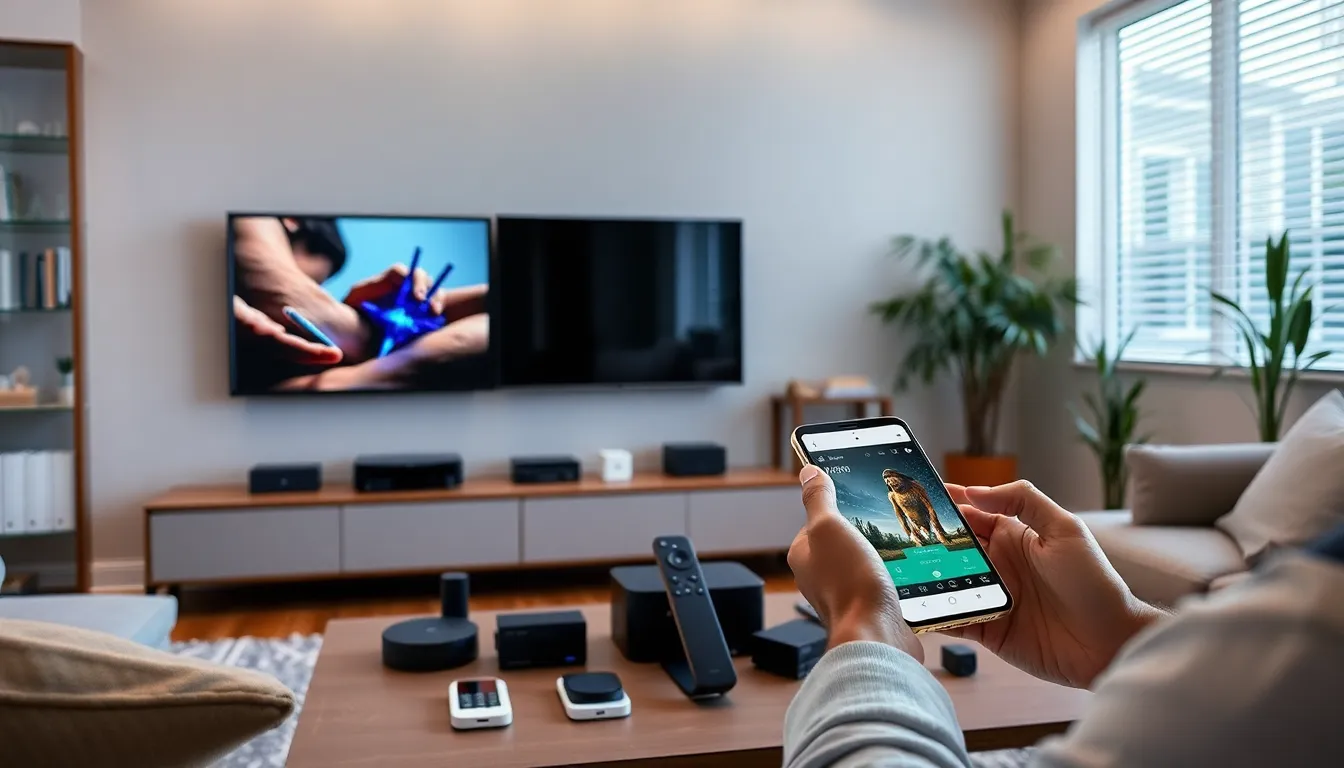In a world where even toasters have Wi-Fi, consumer electronics control has become the new frontier of home automation. Gone are the days of wrestling with remotes like they’re wrestling with a bear. Now, with a simple tap on a smartphone, anyone can command their gadgets to do their bidding, whether it’s dimming the lights or blasting their favorite tunes.
Table of Contents
ToggleOverview of Consumer Electronics Control
Consumer electronics control refers to the capability of managing electronic devices through interconnected systems. This technology streamlines user interactions, enhancing convenience and efficiency in daily routines.
Definition and Importance
Consumer electronics control enables users to operate multiple devices from a single interface, usually via smartphones or dedicated applications. This function reduces the need for multiple remotes and simplifies the user experience. As homes become smarter, the significance of consumer electronics control increases. It empowers users to automate tasks, like scheduling lights and adjusting thermostats, contributing to energy efficiency and improved lifestyle management.
Types of Consumer Electronics
Various types of consumer electronics exist, each catering to specific needs and preferences.
- Smart Speakers: Devices like Amazon Echo or Google Nest facilitate voice control for music, information, and home automation.
- Smart TVs: Televisions that connect to the internet allowing users to stream content and control settings remotely.
- Smart Thermostats: Devices such as the Nest Learning Thermostat optimize heating and cooling systems based on user habits.
- Smart Lighting: Systems like Philips Hue provide options for remote control of lighting settings, colors, and schedules.
- Smart Appliances: Includes refrigerators, washers, and dryers that users can monitor and control through apps.
These devices represent a growing category that exemplifies the intersection of convenience and technology in home environments.
Technologies Behind Consumer Electronics Control

Technologies facilitating consumer electronics control include sophisticated systems that enhance connectivity and user experience. These innovations make it easier to manage multiple devices seamlessly.
Remote Control Systems
Remote control systems operate through infrared signals or radio frequencies, allowing users to command devices from a distance. Infrared remotes transmit signals directly to devices like televisions or audio systems, while radio frequency remotes function without a direct line of sight. Recent advancements incorporate Bluetooth technology, enabling smartphones and tablets to serve as universal remote controls. These systems streamline user interactions by consolidating device controls into one interface, ultimately increasing efficiency in managing home entertainment systems and other electronics.
Smart Home Integration
Smart home integration connects various devices within a single ecosystem, enhancing their interoperability. Hub devices serve as central control points, receiving commands from smartphones or voice assistants and relaying them to compatible gadgets. This integration allows for automated routines, such as scheduled lighting changes or environmental adjustments based on user preferences. Protocols like Zigbee, Z-Wave, and Wi-Fi ensure diverse devices communicate effectively, contributing to a cohesive smart home experience. Such integration simplifies everyday tasks, elevating convenience and energy efficiency.
Benefits of Consumer Electronics Control
Consumer electronics control offers significant advantages, enhancing daily life through improved convenience and energy efficiency.
Convenience and Accessibility
Convenience and accessibility represent key benefits of consumer electronics control. Users manage multiple devices from a single interface, simplifying control of smart devices like speakers, lighting, and thermostats. With voice commands or mobile apps, accessing functionalities becomes seamless, eliminating the need for multiple remotes and complicated setups. Real-time notifications also keep users informed about device status, promoting a more efficient home environment. For instance, scheduling routines for lighting or temperature adjustments occurs effortlessly, allowing users to focus on their activities rather than manual controls.
Energy Efficiency
Energy efficiency plays a crucial role in consumer electronics control. Automated systems optimize energy consumption by adjusting appliance settings based on user habits and preferences. Smart thermostats, for example, learn temperature patterns, reducing energy use when the home is unoccupied. Additionally, interconnected devices facilitate energy monitoring, empowering users to track usage and identify areas for savings. By minimizing energy waste, these technologies not only lower utility bills but also support sustainable living practices in modern households. Benefits extend to environmental impact, as reduced energy consumption contributes to a more sustainable future.
Challenges in Consumer Electronics Control
Consumer electronics control faces significant challenges that can hinder user experience and device efficiency. Two primary concerns include compatibility issues and security concerns.
Compatibility Issues
Compatibility issues frequently arise in consumer electronics control due to diverse manufacturers and standards. Many devices may not seamlessly communicate, limiting user options. For example, smart speakers from one brand often struggle to control smart lighting from another brand without proper integration. This fragmentation restricts the user experience and extends setup times, as users must navigate complex ecosystems to ensure all devices work together.
Security Concerns
Security concerns pose substantial risks in consumer electronics control. Vulnerabilities in device firmware or communication protocols may expose users to hacking attempts. For instance, unsecured smart cameras can leak personal footage online, risking privacy. Additionally, inadequate encryption measures can lead to unauthorized access to home networks. Ensuring robust security features requires ongoing updates and user awareness, adding complexity to the convenience that these technologies aim to provide.
Future Trends in Consumer Electronics Control
Emerging trends in consumer electronics control highlight advancements that create smarter, more interconnected environments.
IoT and Automation
IoT technology continues to shape consumer electronics control by fostering device interconnectivity. Devices communicate seamlessly through the Internet, enabling automation that enhances user experience. For example, smart thermostats connect with weather data to optimize heating and cooling based on real-time conditions. Home appliances can schedule operations based on energy rates. This integration allows users to create comprehensive automation routines, improving energy efficiency and comfort in daily living. Industry forecasts predict that by 2025, over 75 billion IoT devices will be in use globally, solidifying their role in transforming consumer electronics landscapes.
Voice-Activated Technology
Voice-activated technology is revolutionizing consumer electronics control by providing hands-free interactions. Users command devices using natural language, simplifying control and enhancing accessibility. Smart speakers and virtual assistants, such as Amazon Alexa and Google Assistant, enable voice commands to manage multiple devices effortlessly. For instance, users can adjust lighting, play music, or converse with smart appliances through simple verbal requests. This technology enhances user engagement, making home automation more intuitive. As natural language processing advances, voice-activated systems are expected to become increasingly responsive and accurate, further driving their adoption in consumer electronics.
The landscape of consumer electronics control is rapidly evolving. As technology advances the integration of smart devices continues to enhance convenience and energy efficiency in everyday life. Users now enjoy seamless management of their gadgets through a single interface which simplifies daily tasks and promotes sustainable living.
While challenges like compatibility and security remain, ongoing innovations in IoT and voice-activated technology promise to address these issues. The future of consumer electronics control looks bright with potential for even smarter and more intuitive home environments. Embracing these advancements will not only streamline routines but also contribute to a more connected and efficient lifestyle.




